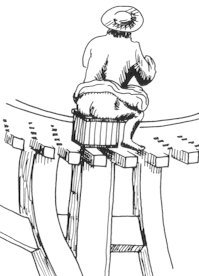Ship Waste Disposal
Today, we try to keep ships clean. The University of Houston's College of Engineering presents this series about the machines that make our civilization run, and the people whose ingenuity created them.
When I was a graduate student, years ago, I worked one summer for Albert Einstein's son, Hans Albert. Hans Albert Einstein was a distinguished sanitary engineer. I designed apparatus for a flume where he was modeling the movement of human waste.
His work was subtle, and I learned something about contradiction from him. For he took the earthiest of problems, turned it around, and abstracted it. And that's not how we usually handle the essential and perpetual problem of dealing with our own waste.
Waste disposal loomed large as the size and range of the old sailing vessels increased. Anthropologist Joe Simmons writes about this problem, which you might think would be no problem at all -- the ocean being as large as it is. No doubt, the earliest sailors did simply relieve themselves over the rail.
The larger crews became, the more impractical that also became. We find evidence of chamber pots on board ship all the way back to Roman times. But they too grew impractical when ships became big wooden structures with layers of enclosed decks.
Each of those internal decks had to be provided with drainage toward the outside of the ship. In the course of shipboard life, slop buckets slopped over. The old wooden ships were never watertight, and all kinds of effluvia leaked through successive floors to end up with the bilge at the bottom. By the 16th century, any ship grew increasingly foul as you moved downward from deck to deck and finally reached a built-in cesspool just above the keel.
That changed somewhat when Renaissance warships sprouted castle-like battle towers on the bow and stern. Indeed, the word fo'cs'l or forecastle reminds us of the kinship of the new ships to the old castles. Waste disposal in a castle was achieved by building a privy out from the castle wall, over the moat. And what was a ship but a floating castle with a very large moat around it!
What happened next reflects in Simmons' title, Those Vulgar Tubes. Since ancient times, privileged travelers were now and then provided with a privy structure sticking out over the water. By the 1400s shipbuilders began equipping ships' battle towers with privies that discharged into rectangular tubes running down into the water. They began building urinals along the side. The word "head" comes from facilities often located near the figurehead on the bow.
Not 'til we had this century's fast-moving steam-powered iron ships did we move beyond that hole-in-the-deck technology. Solving the problem of dealing with our own waste seldom attracted the kind of subtle thinking that's needed to solve any really hard problem.
Hans Einstein's subtle fluid mechanics and abstract modeling were an exception, they weren't the rule. But then, I suppose, it's only human to want to apply our more elegant thinking to less repellant -- if less vital -- problems.
I'm John Lienhard, at the University of Houston, where we're interested in the way inventive minds work.
(Theme music)
Simmons, J. J., Those Vulgar Tubes: External Accommodations Aboard European Ships of the Fifteenth Through Seventeenth Centuries, College Station, TX: Texas A&M Press, 1997.


Examples of 15th C (left) and 17th C (right) shipboard accommodations.
(by permission of Dr. Joe Simmons III.)